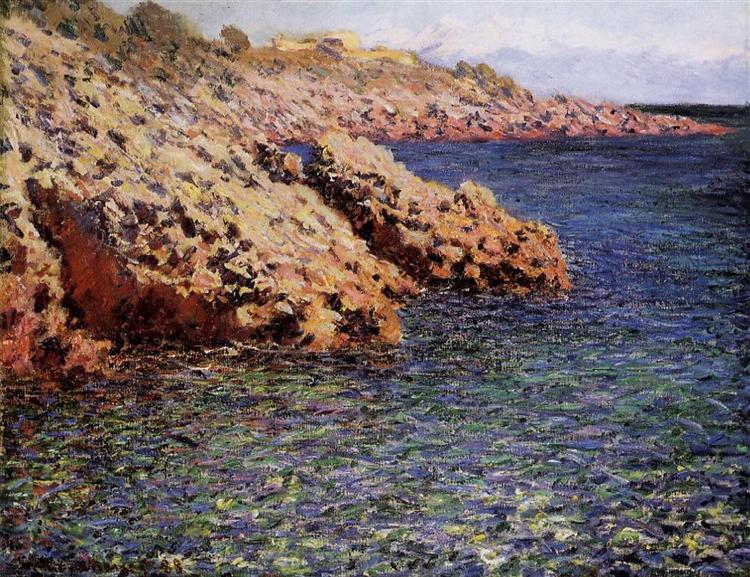Description
Claude Monet's 1888 painting "Rocks on the Mediterranean Coast" is a prime example of the evolution of Impressionism, a movement the artist helped define in the late 19th century. In this painting, Monet captures the essence of the Mediterranean landscape with a technique that highlights not only the beauty of the natural surroundings, but also its vibrant, ever-changing atmosphere.
The painting is characterised by a composition that invites the viewer to immerse themselves in a tranquil yet vibrant scene, where rocks emerge in their robust and organic form. These rocks, with their rich texture and monumental presence, are the focal point of the work and are portrayed with a colour palette that oscillates between greys and ochres, enhancing their shapes against the softer background of the sea. The interplay of light on the rocky surfaces is masterfully observed; Monet, true to his style, plays with the effects of light and shadow, creating a dynamism that reflects the movement of the water and the atmosphere of the moment. Loose and rapid brushstrokes are characteristic of his technique, allowing both the representation of concrete details and a more ethereal and general effect.
Color is a primary element in Rocks on the Mediterranean Coast. Monet uses a range of blue tones that evoke the serenity of the sea, nuanced with warmer elements that suggest the warmth of the Mediterranean environment. The color transitions are smooth, allowing the viewer to feel the sea breeze and sunlight. This use of color not only defines the visual composition, but also provokes an emotional response, transporting the viewer to the calm of the coastline.
It is notable that in this work, the focus remains on the landscape itself, without the inclusion of human figures, something Monet often did in other works. This choice highlights a search for the purity of the natural environment, potentially as a response to the industrialisation of the time and its impact on natural spaces. Through this solitude in the landscape, Monet proposes an introspective contemplation, allowing the viewer to experience the grandeur and majesty of the sea and rocks without distraction.
The context of Rocks on the Mediterranean Coast is set within a period when Monet produced several works inspired by the Mediterranean. His trip to the region not only allowed him to explore a brighter, more vibrant palette, but also to transcend the limitations of his own French surroundings. This painting is a glorification of nature, in which Monet manages to encapsulate a fleeting moment, which becomes eternal through its capture on canvas.
With this work, Monet reaffirms his role as an innovator of Impressionism, embracing light, color, and form in a way that continues to resonate with art lovers and scholars alike. Rocks on the Mediterranean Coast is not only a depiction of a specific place, but a meditation on the relationship between humans and nature, a theme that remains relevant in contemporary art and invites reflection on our own connection to the natural environment.
KUADROS ©, a famous painting on your wall.
Hand-made oil painting reproductions, with the quality of professional artists and the distinctive seal of KUADROS ©.
Painting reproduction service with satisfaction guarantee. If you are not completely satisfied with the replica of your painting, we will refund 100% of your money.

